From scuba diving to snowboarding, patients in the pediatric intensive care unit leave the hospital behind with virtual reality
For the first time in a pediatric intensive care unit (PICU), patients get a chance to scuba dive, snowboard, and go on a safari or other adventures, all from their hospital bed. The 360 degree immersions into virtual environments were extremely well received by PICU patients and their parents, according to results from a pilot study from Ann & Robert H. Lurie Children’s Hospital of Chicago that were published in Pediatric Critical Care Medicine. All 32 study participants, ages 3-17 years, reported that they enjoyed using virtual reality. All of their parents agreed, with over 80 percent reporting that virtual reality experience calmed their child.
“We conducted this study to make sure that it is feasible to introduce virtual reality into a pediatric intensive care setting and that kids respond well to it,” says senior author Marcelo Malakooti, MD, from Lurie Children’s who also is Assistant Professor of Pediatrics-Critical Care at Northwestern University Feinberg School of Medicine. “We are now introducing virtual reality more broadly to critically ill children on the unit who are often alert, but stuck in bed just passively watching TV. Such minimal engagement with their environment over prolonged hospitalization can lead to delirium or other cognitive and emotional impairments. We hope that the stimulation and interaction that virtual reality offers will mitigate that risk and improve outcomes for these children.”
Based on the positive results of the pilot study, Dr. Malakooti, lead author Colleen Badke, MD, and colleagues at Lurie Children’s are now conducting a larger study to examine how virtual reality use in the PICU impacts pain, anxiety and physical factors like blood pressure and heart rate variation, among others.
###
Research at Ann & Robert H. Lurie Children’s Hospital of Chicago is conducted through the Stanley Manne Children’s Research Institute. The Manne Research Institute is focused on improving child health, transforming pediatric medicine and ensuring healthier futures through the relentless pursuit of knowledge. Lurie Children’s is ranked as one of the nation’s top children’s hospitals in the U.S.News & World Report. It is the pediatric training ground for Northwestern University Feinberg School of Medicine. Last year, the hospital served more than 212,000 children from 49 states and 51 countries.
Media Contact
Vita Lerman
[email protected]
http://dx.




